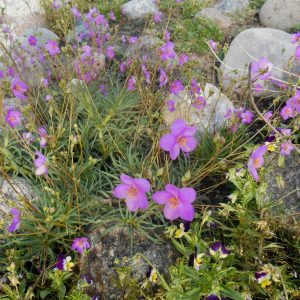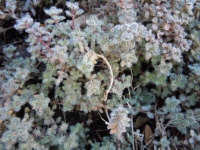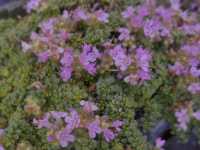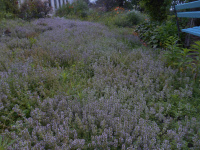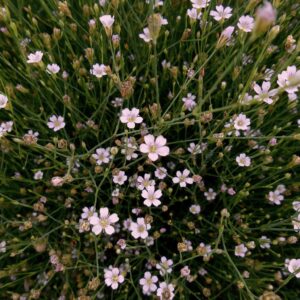Alpine, Rock, Miniature, Bonsai and Railroad Gardens
Showing 73–80 of 85 results
-
Talinum calycinum syn. Phemeranthus calycinus Rock rose, Fameflower Z 6-9
Bright mauve flowers dance on wiry stems in afternoons all summer, closing at night. Leaves are succulent.
Tender reseeding perennial, but they survived the horrible winter of 2013-14. In any event they reseed reliably. Just watch for little succulent leaves.
Bright mauve flowers dance on wiry stems in afternoons all summer, closing at night. Leaves are succulent.
Size: 8-12” x 4”
Care: Sun in well-drained soil
Native: western Plains statesCollected by Dr. Frederick Wislizenus on sandy soil near the Cimarron River on an exploring trip of Texas, New Mexico and Mexico in 1846. Wislizenus (1810-1889) was a German immigrant, explorer, botanist, and medical partner of George Engelmann (1809-1884) important promoter of plant-hunting and expert on cacti and conifers.
-
Teucrium montanum Mountain germander, Creeping germander Z 5-8
Evergreen, narrow leaves covered with bouquets of flowers topped with a pair of upright, clasping petals streaked with burgundy, leading to a pair of open, white arms and a single, drooping white petal all resembling a snowman with a pointed red-streaked head blooming all summer on this spreading, cover-the-ground, drought-tolerant plant.
Evergreen, narrow leaves covered with bouquets of flowers topped with a pair of upright, clasping petals streaked with burgundy, leading to a pair of open, white arms and a single, drooping white petal all resembling a snowman with a pointed red-streaked head blooming all summer on this spreading, cover-the-ground, drought-tolerant plant.
Size: 10” x spreading
Care: sun in well-drained soil
Native: Spain across the Alps and east as far as TurkeyThe word teucrium believed to be named for Teucer, king in ancient Troy . He reputedly made medicine from teucrium. Known more than two centuries ago in ancient Greece and Rome
-
Thalictrum alpinum Alpine meadowrue Z 2-9
Flowering June, purple skirt surrounding dangling yellow anthers on this petite Meadowrue
OUT OF STOCK
Flowering June, purple skirt surrounding dangling yellow anthers on this petite Meadowrue
Size: 8” x 4”
Care: sun to part shade in moist to moist well-drained soil
Native: Mountains Western US, north to Alaska, Eastern Canada, Siberia, Europe & ChinaThalictrum is from Greek meaning “to flourish” or “look green.” In China called “gao shan tang cao.” Collected before 1679.
-
Thymus pseudolanuginosus Woolly thyme Z 4-8
Wonderful groundcover or in rock gardens for its miniature, very hairy silver leaves, resembling wool. Lavender flowers in June.
Grown as a groundcover or in rock gardens for its miniature, very hairy silver leaves, resembling wool. Lavender flowers in June.
Size: 1” x 12” spreading slowly
Care: sun to part shade in well-drained soil.
Native: Europe
Wildlife Value: Drought tolerant. Deer resistantThymus from the Greek word for “odor” due to the plant’s fragrance. Ancient Greeks made incense with thyme. This species 1st mentioned in Gardeners Dictionary by Phillip Miller of Chelsea Physic Garden fame, 1771.
-
Thymus serpyllum ‘Minus’ syn. T. praecox ‘Minus’ Dwarf thyme Z 2-9
Purple flowers cover evergreen foliage in late spring on this tiny thyme-leaved plant. Good groundcover or for rock gardens
Purple flowers cover evergreen foliage in late spring on this tiny thyme-leaved plant. Good groundcover or for rock gardens
Size: 3” x 12” and spreading
Care: sun to part shade in moist well-drained to well-drained soil
Native: Europe
Wildlife Value: Deer resistant.
Size: Great for rock gardens, groundcover, drought tolerant.Thymus from the Greek word for “odor” due to the plant’s fragrance. Ancient Greeks made incense with thyme. ‘Minus’ described by Parkinson in 1640. He called it Thymus serphyllum vulgare minus.
-
Thymus serpyllum syn. Thymus praecox Mother-of-thyme, creeping thyme Z 4-9
Short purple spikes in June-July
Short purple spikes in June-July
Size: 3” x 24”
Care: sun in well-drained soil
Native: Europe & Western Asia
Size: groundcover, rock garden, herb, fragrant foliage, thyme lawnThymus from the Greek word for “odor” due to the plant’s fragrance. Ancient Greeks made incense with thyme. This species since at least 1753. Acc’d to Parkinson in 1640 this remedied hysterics in women. Wm. Robinson wrote,”nothing can be more charming than a sunny bank covered with” Thymus serpyllum. LH Bailey extolled it as “prized as an evergreen edging and as cover for rockwork and waste places …The leaves are sometimes used for seasoning.”
-
Tunica saxifraga syn. Petrorhagia saxifraga Tunic flower Z 4-8
Free blooming pixie, palest of pink blossoms from June through October on wiry stems form a 4" tall mound.
Free blooming pixie, palest of pink blossoms from June through October on wiry stems form a 4″ tall mound.
Size: 6" x 8"
Care: Full sun in well-drained soil.
Native: Pyrenees and Alps
Wildlife Value: Drought tolerant.
Awards: Royan Horticultural Society Award of Merit.
Size: Perfect for rock gardens, front of borders or groundcover.Tunica is Latin meaning tunic or coat referring to overlapping bracts beneath the flower. Before 1753. Near 1900 William Robinson (1838-1935) described the Tunic flower as having “elegant little rosy flowers … a neat plant for the rock garden and fringes of borders and thrives like a weed between the stones in a rough stone wall.”
-
Umbilicus oppositifolius syn. Chiastophyllum oppositifolium Lamb’s tail Z 5-9
For shady gardens, a low mound of thick, succulent green leaves, bearing arching, upright stems with dangling chains of sulphur yellow flowers in May-June.
OUT OF STOCK
For shady gardens, a low mound of thick, succulent green leaves, bearing arching, upright stems with dangling chains of sulphur yellow flowers in May-June.
Size: 6-8” x 10-12”
Care: part shade in moist to moist well-drained soil
Native: Caucasus Mountains
Awards: Recipient Royal Horticultural Society Award of Garden Merit1st described and named as Cotyledon oppostitfoilum in Bulletin scientifique (publié par l’) Académie Imperiale des Sciences de Saint-Pétersbourg 2: 813. 1837.

